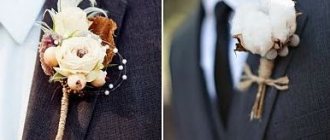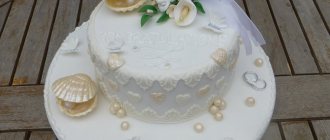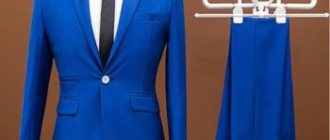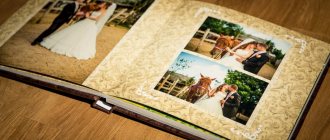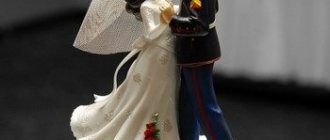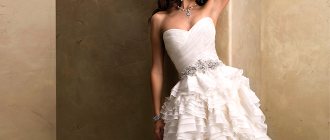Your own wedding is the very occasion when even an inveterate opponent of all kinds of “embellishment” is ready to choose accessories for a suit in addition to the usual tie. A bow tie, eye-catching hairpins (read more about men's hairpins for shirts and under ties), a starched scarf peeking out of the breast pocket... But this whole “groom's formal set” can easily be overshadowed by an original boutonniere brooch (English boutonniere) or a live one a flower in the buttonhole of a jacket - making the hero of the ceremony truly irresistible.
What is
A boutonniere is a single flower or a small floral arrangement attached to the buttonhole on a men's suit. A boutonniere is made from fresh flowers, artificial buds, leaves, decorative twigs, and berries. Its size is no longer than ten centimeters, including the peduncle.
The tradition of decorating men's clothing with flowers first appeared during Antiquity. But the word “boutonniere” itself came from France, where in the 17th-18th centuries this accessory became widespread as a symbol of wealth and high social status. Today it is a decorative element of a man’s image, intended for special occasions, but at the beginning of the 20th century not a single gentleman went out without it.
From French, “boutonniere” translates as “flower in the buttonhole.” This fashion accessory symbolized the beauty of nature, male fearlessness, and the fragility of human life.
The first wedding boutonnieres appeared in the 19th century after Prince Albert of England took a flower from his bride Victoria’s bouquet and inserted it into his buttonhole. Today, the boutonniere has become a mandatory attribute of the groom's suit.
Attaching the boutonniere depending on the material
There may be problems with attaching a brooch or bouquet if they are too heavy, large or made of fresh flowers. In other cases, 1-2 pins and a few minutes are enough. To avoid any difficulties during the wedding celebration, it is worth practicing with the clasp in advance, taking into account the material of the product and its weight.
For a jacket with pockets
It is a mistake to place a festive composition in your pocket (like a scarf). So the flower will simply fall out during a dance or hug, or get lost during photography or competitions. It is necessary to secure it with a clamp, pin, or clip.
It is recommended to select a special boutonniere for jacket pockets, attaching it to the top. It is wide, like a stripe, replaces a bright scarf and emphasizes the individuality of a man.
For a jacket without pockets
You need to attach the accessory to the left lapel of a jacket without pockets with a safety pin or clasp, hiding it from the inside.
On a jacket without pockets, the boutonniere is attached with a special clasp.
You can insert a flower into a loop, but it is not recommended to hide the stem. It is placed parallel to the fold, holding it with a clamp. The upper part of the composition should cover the slot.
The massive bouquet is secured under the main flower, additionally fastened at the bottom with a second safety pin or magnet. Sometimes 3 fastening elements are required if heavy cones, beads, rhinestones, or stones are used for decoration.
On a shirt
Many grooms do not wear a jacket or vest, limiting themselves to a shirt and tie. In this case, the bouquet is attached to the pocket or on the left side, closer to the neckline. You can place the decoration above the pocket if it is small so that it does not pull on the fabric.
A mini-bouquet attached to the left strap of suspenders looks original if they are included in the style of the celebration.
In this case, you can choose a bright flower or an unusual brooch to match the wedding theme.
Composition options
Stylists recommend paying special attention to the groom’s boutonniere, because it will attract no less attention than the bride’s bouquet. When choosing a flower arrangement design, you need to consider the following points:
- The design of this decoration should be harmoniously combined with the overall style of the celebration. For a classic wedding, a single rose, chrysanthemum or peony is perfect. If the wedding is in a nautical style, you can attach a boutonniere with burlap, shells, and tiny starfish. For a rustic style, daisies, herbs, flax, and ears are more suitable.
- The flower on the groom's suit must match the bride's wedding bouquet. It is ideal if the flowers of the bride and groom are the same or as similar as possible in shade and size.
- The boutonniere should be firmly attached to the suit. It is not enough to simply insert the flower stems into the buttonhole; you need to secure them with a special pin.
- A floral accessory should not be too bright, large, or contain many decorative elements.
When making boutonnieres from fresh flowers, you need to make sure that they do not leave marks on your clothes. Some buds have too much pollen, which can ruin not only the groom's suit, but also the bride's dress.
The groom's boutonniere comes in several composition design options:
- One flower. As a rule, a fairly large rose, peony, iris, orchid, or chrysanthemum are selected for a single composition.
- Miniature bouquet. It can consist of several flowers of approximately the same size or one flower surrounded by greenery, buds, inflorescences, and other decorative elements.
- Brooch. For a glamorous wedding, instead of a traditional floral accessory, a brooch in the shape of a bud, bouquet, key, feather or even an insect is often preferred.
The groom chooses the brightest boutonniere for himself, and more modest floral accessories are selected for the invited guests to stand out from their background.
Boutonniere for the groom
Content
Now that many wedding traditions have been revised more than once, many couples are faced with the question of whether the groom needs a boutonniere at all. In order to answer this question, we suggest you familiarize yourself a little with the history of this accessory.
According to custom, after the bride ransomed, she took a flower from her bouquet and pinned it on the lapel or pocket of the groom's jacket. This gesture symbolized acceptance of the future husband and an expression of love and fidelity. Therefore, to this day, even when a florist creates the bride’s bouquet and the groom’s boutonniere separately, special attention is paid to ensuring that the style and color of these elements are consistent.
Some also say that such an accessory on the groom’s jacket marks the special solemnity of the event, because men’s wardrobe in everyday life is quite laconic, and it is not customary to decorate it. But on the wedding day everything is different, and therefore the choice of this element should be treated with special attention.
Symbolism of flowers
Each flower represents a specific symbol and has its own meaning:
- Peonies symbolize romance, good luck in love, and prosperity. In China, peonies are associated with feminine grace, beauty, and charm. According to Feng Shui, girls place them in an apartment to attract a loving and caring groom. For weddings, it is preferable to use pink, white and cream peonies.
- Roses are classic wedding flowers, symbolizing love at first sight, strong friendship, passion and sensuality. Particular attention should be paid to choosing the color of roses. Red symbolizes ardent passion, desire, love. Burgundy indicates admiration. Snow-white roses are traditionally associated with purity, fidelity, and sincere feelings. Pink - the birth of relationships, tender feelings, emotions. It is better to avoid using yellow roses in wedding accessories: they are considered a symbol of separation and betrayal.
- Orchids symbolize luxury, beauty and elegance. In nature, they are found in different shapes and colors, but for a boutonniere it is better to choose medium-sized orchids in delicate shades: white, cream, pink, pale blue.
- Tulips are associated with fidelity, passionate love, youth and prosperity. They look elegant both in monocomposition and in combination with small buds and inflorescences.
- Lavender is a favorite for Provence-style wedding ceremonies. She is credited with the properties of a talisman against evil forces, the ability to attract longevity and happiness in family life.
Floral accessories do not have to be made from fresh flowers. To create original boutonnieres, designers often use artificial materials. Each of them is selected in accordance with the overall style of the wedding, the image of the bride and groom.
Lavender
Orchid
Peony
Rose
Tulip
Necessary accessories for the costume
The look becomes complete only with the right accessories. The most important of them is a tie or bow tie. You should choose bright colors and original models. A wide tie should not be worn with an outfit without a jacket. Narrow or medium width is optimal. The belt is selected in the same palette as the shoes.
This is interesting: Men's three-piece wedding suit - how to choose the right one?
When wearing a formal suit, a man should choose socks that match his shoes. This rule does not apply to free style. Extravagant options have now become the rage of men's fashion, and this trend has not bypassed wedding preparations. The groom can wear socks in bright solid colors or with some kind of pattern. For example, polka dots, diamonds, etc. They should fit well into his image and be combined with the bride’s outfit.
Main materials of manufacture
The groom's boutonniere is made from the following materials:
- Made from fresh flowers - such an accessory looks natural and natural, but loses its original freshness long before the end of the wedding. Therefore, when choosing this option, florists recommend stocking up on a second copy, which can be worn if the first one fades.
- Artificial flowers are a more practical option, which is preferred at weddings in the cold season. Such decoration will not stain the suit, will not turn black, and will delight the eye with its fresh appearance throughout the entire celebration.
- Made from foamiran - a soft material used to create various flower arrangements. These boutonnieres look quite natural, gentle, and elegant.
- From multi-colored ribbons - using the kanzashi technique, you can make a variety of floral accessories from ribbons. Satin roses, chrysanthemums, daisies, peonies will become a bright detail on the groom's suit. You just need to choose a good color combination, not to overdo it with the brightness of colors or originality of shapes.
- From organza and mesh - from floral material, light original boutonnieres are obtained, which are additionally decorated with a special mesh along the edges. If desired, the mesh is decorated with berries, rhinestones, beads or feathers.
- Silk is a delicate, thin material that successfully imitates the shape of buds, leaves, and flower inflorescences.
- From polymer clay, you can make such a boutonniere yourself, since it does not need to be baked. It is enough to give the polymer clay the desired shape, and it will harden itself within a day. Wire pre-wrapped in green tape is used as stems for clay buds.
To keep a bouquet of fresh flowers fresh for a long time, you first need to cut each flower stem obliquely and then dip it in wax.
Natural flowers
Ribbons Artificial Flowers
Polymer clay
Foamiran
Vest as an alternative to a jacket
In the classic version, the vest is part of a three-piece suit. In recent years, menswear designers have made the waistcoat a stand-alone item in a gentleman's wardrobe. The vest allows you to create a stylish look for the groom without a jacket. It is to this that the groom pins his main wedding attribute – a boutonniere.
When choosing a vest, the main principle of choosing a suit with a jacket applies - it should look harmonious with the bride’s outfit. This effect is obtained when the color scheme and texture of the fabric, as well as the style of the vest, go well with the wedding dress. Therefore, wait until your chosen one decides on her wedding outfit, and then go in search of a vest.
The first thing you should pay attention to is the fabric. It is the quality of the fabric that characterizes the groom’s taste. Modern vests are made not only from satin, but from all kinds of suit fabrics. Choose natural fabrics in which the content of synthetic threads is minimized. For the cold season, it is preferable to choose wool, and for the warm season, fine wool, linen and silk.
All shades go well with a snow-white dress, and an ivory-colored outfit should be emphasized with a similar color scheme, which includes beige, sand, coffee and brown shades. When choosing a style, it is necessary to emphasize the strengths of the figure and hide minor flaws. For example, loose models are more suitable for overweight men.
This is interesting: How to choose the right men's wedding shoes?
https://www.instagram.com/p/BHq3QfPgcCI/
The most important advice is to choose a product that will not only fit you well when you stand, but will be comfortable when moving. After all, the groom at the wedding will have to walk a lot, dance, and also take part in various competitions. You can choose the perfect vest for yourself after trying on several models of different cuts and colors.
The groom is wearing a shirt without a jacket.
Creative modern ideas
Designers love to break the traditional idea of what a boutonniere is. They create this wedding accessory from the most unusual materials, combinations of colors and shapes. Among the original ideas for boutonniere design are:
- Marine version - twine, shells, stars, pearls, pieces of coral are used to make it.
- In the steampunk style - a composition of clock mechanisms, keys, feathers.
- In a rustic style - a bouquet consisting of several ears of corn, buttons, tiny sunflowers or dried cotton flowers.
- Autumn design - red berries, small cones, branches of evergreen bushes (arborvitae, juniper, boxwood, cherry laurel).
Country style
Marine style Autumn
Steampunk
Master class on floristry: Frame for a bouquet
Published: November 20, 2022 2:16 am
You can use completely different things as the basis for creating a bouquet or composition - baskets, flowerpots, vases, coconut shells and much, much more. Bouquets collected on various frames look very good. The frame gives the bouquet shape, creates structure and clarity of the composition.
A wide variety of frames for bouquets are sold in specialized stores for florists, but such a store is not always in your city or it is not possible to get to it.
Today I will present to your attention one of the frame options, which you can easily make yourself if you don’t have a ready-made one at hand, but you really want to put together a bouquet.
- Kulabukhova Ekaterina
- Author's store
- We will need:
- Cardboard. You can use a clean box.
- The material for decorating cardboard is organza, corrugated paper, foil or, as in our case, floral felt.
- The wire, in our example, is a special floral wire, but you can also use ordinary electrical wire, the main thing is that it is single-core and not made of many thin wires, as this will not hold its shape.
- Glue gun or glue.
We cut out a circle from cardboard of the diameter we need. It is convenient to use a plate and a cup for the template.
We cut the felt into strips - the length of the strip should be such as to wrap our “donut” with an overlap of 2-3 cm, the width is approximately 7-10 cm, but this depends on the size of the workpiece.
We begin to decorate the cardboard base, because... Since we have a circle as a base, we lay the folds taking into account the geometry of the workpiece - deeper towards the center.
We glue each next strip onto the previous one.
We fill the entire circle.
Next we make something like a holder for the frame.
We use an awl to pierce holes, in our case four, diametrically opposite.
Take the wire and bend it in half.
We fix it on the frame.
The design is ready, but the inside is not very beautiful. You can decorate it with completely different elements, I suggest one of the options.
We take artificial leaves.
Wrinkled? No problem! A kettle will help us. Hold the leaves over steam and they will straighten.
- Glue the leaves with hot glue to the wrong side of the frame, covering the joint of the felt strips.
- The following photos refer to my version of the bouquet; your decor may be completely different, in accordance with the style of the composition.
But what can be useful to everyone is a piece of oasis for dry ones, for the convenience of forming a bouquet. I simply glue the oasis with hot glue.
And bouquets on a similar frame.
How to position and secure
Having decided on the design of the floral accessory, you need to find out how the boutonniere is attached to the jacket. Traditionally, the composition is attached not only to the groom’s suit, but also to the clothes of witnesses and other guests at the wedding. At the same time, each participant in the wedding celebration has their own rules for wearing this accessory:
- First of all, you need to decide where to attach the boutonniere to the groom. He should place a floral accessory on the left lapel of his jacket. For reliability, the bouquet is fixed with a special pin, which is masked with ribbons, decorative mesh, and beads.
- Bridesmaids should also decorate their outfit with a miniature floral arrangement. They can attach it to their wrist, belt, hair band, purse or even neckline. For bridesmaids, there is a certain rule on which side to hang the boutonniere: unmarried ones fix it on the left, married ones on the right.
- Unmarried groomsmen can place a floral accessory directly on the shirt. As in the case of girls, the location of the bouquet depends on marital status. Unmarried people should attach the boutonniere to the jacket on the left side, and married people - on the right.
When choosing a boutonniere, you need to take into account many details: design, shape of the composition, materials. You can make this accessory yourself or entrust this task to professionals.
Examples of attaching and wearing a men's boutonniere
There are many options for how to wear a boutonniere for the groom. If you want to deviate from tradition, you can even put it on your hand, making it into a bracelet. But more often brides and their bridesmaids do this. The groom is advised to pay attention to other methods of attachment.
The boutonniere is worn on a vest, placed in the heart area.
Ideas for wearing a decorative bouquet:
- on the lapel of the jacket along the fold, complementing it with a handkerchief in the pocket, selected in one color;
- on the vest, placing it in the heart area;
- on the left strap of colored suspenders;
- fastened to your pocket with a special clip;
- between the buttons of the shirt and the sleeve, exactly in the middle.
Where to attach the composition needs to be decided before the wedding event, having rehearsed the process with the bride. Then there will be no awkward questions or hesitations.
